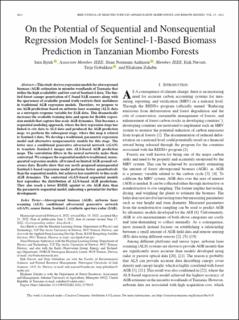| dc.contributor.author | Björk, Sara Maria | |
| dc.contributor.author | Anfinsen, Stian Normann | |
| dc.contributor.author | Næsset, Erik | |
| dc.contributor.author | Gobakken, Terje | |
| dc.contributor.author | Zahabu, Eliakimu | |
| dc.date.accessioned | 2023-04-04T11:51:00Z | |
| dc.date.available | 2023-04-04T11:51:00Z | |
| dc.date.created | 2022-08-16T09:28:17Z | |
| dc.date.issued | 2022 | |
| dc.identifier.citation | IEEE Journal of Selected Topics in Applied Earth Observations and Remote Sensing. 2022, 15 4612-4639. | |
| dc.identifier.issn | 1939-1404 | |
| dc.identifier.uri | https://hdl.handle.net/11250/3062092 | |
| dc.description.abstract | This study derives regression models for aboveground biomass (AGB) estimation in miombo woodlands of Tanzania that utilize the high availability and low cost of Sentinel-1 data. The limited forest canopy penetration of C-band SAR sensors along with the sparseness of available ground truth restricts their usefulness in traditional AGB regression models. Therefore, we propose to use AGB predictions based on airborne laser scanning (ALS) data as a surrogate response variable for SAR data. This dramatically increases the available training data and opens for flexible regression models that capture fine-scale AGB dynamics. This becomes a sequential modeling approach, where the first regression stage has linked in situ data to ALS data and produced the AGB prediction map; we perform the subsequent stage, where this map is related to Sentinel-1 data.We develop a traditional, parametric regression model and alternative nonparametric models for this stage. The latter uses a conditional generative adversarial network (cGAN) to translate Sentinel-1 images into ALS-based AGB prediction maps. The convolution filters in the neural networks make them contextual. We compare the sequential models to traditional, nonsequential regression models, all trained on limited AGB ground reference data. Results show that our newly proposed nonsequential Sentinel-1-based regression model performs better quantitatively than the sequential models, but achieves less sensitivity to fine-scale AGB dynamics. The contextual cGAN-based sequential models best reproduce the distribution of ALS-based AGB predictions. They also reach a lower RMSE against in situ AGB data than the parametric sequential model, indicating a potential for further development. | |
| dc.description.abstract | On the Potential of Sequential and Nonsequential Regression Models for Sentinel-1-Based Biomass Prediction in Tanzanian Miombo Forests | |
| dc.language.iso | eng | |
| dc.title | On the Potential of Sequential and Nonsequential Regression Models for Sentinel-1-Based Biomass Prediction in Tanzanian Miombo Forests | |
| dc.title.alternative | On the Potential of Sequential and Nonsequential Regression Models for Sentinel-1-Based Biomass Prediction in Tanzanian Miombo Forests | |
| dc.type | Peer reviewed | |
| dc.type | Journal article | |
| dc.description.version | publishedVersion | |
| dc.source.pagenumber | 4612-4639 | |
| dc.source.volume | 15 | |
| dc.source.journal | IEEE Journal of Selected Topics in Applied Earth Observations and Remote Sensing | |
| dc.identifier.doi | 10.1109/JSTARS.2022.3179819 | |
| dc.identifier.cristin | 2043271 | |
| cristin.ispublished | true | |
| cristin.fulltext | original | |
| cristin.qualitycode | 1 | |
